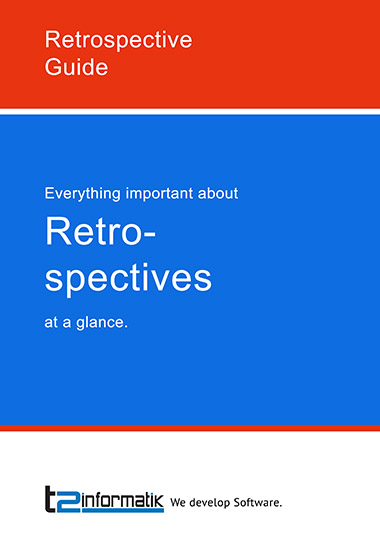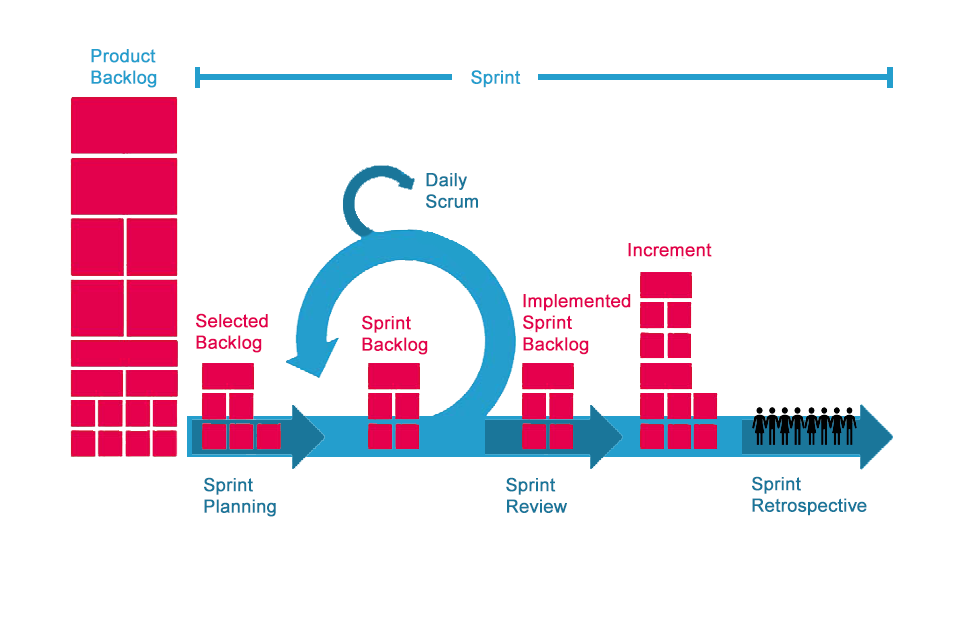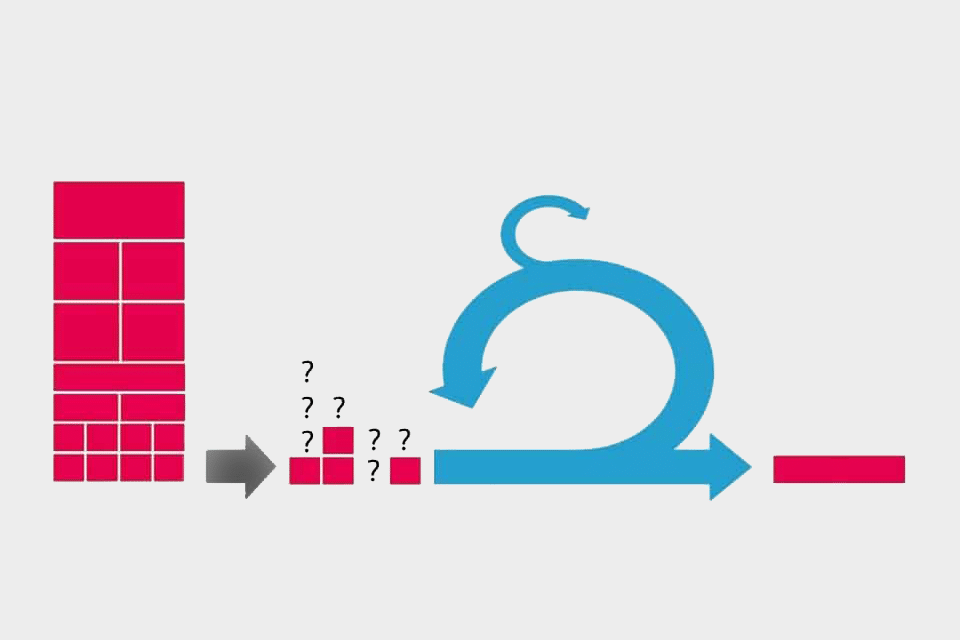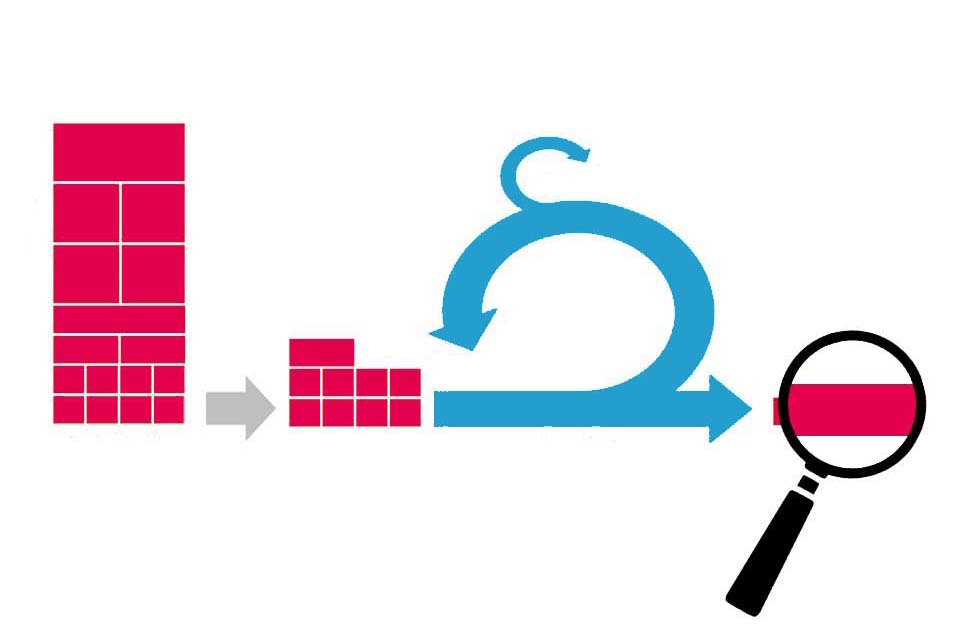What is a Scrum Retrospective?
Table of Contents: Definition – Phases – Goals – Types – Tips – Questions from the field – Download – Notes
Smartpedia: The Scrum Retrospective is a meeting of developers, Scrum Master and Product Owner at the end of a sprint with the aim to improve the cooperation between each other.
Scrum retrospective definition
A retrospective is a recap. As a term in art, it describes the examination of works by an artist and/or an epoch. In Scrum, a retrospective is a regular event where the development team meets to illuminate the recent past – the past sprint – and thereby improve future teamwork. It is a meeting where
- processes and workflows,
- tools,
- skills,
- relationships,
- teamwork
- general and specific challenges and
- experiences
are reflected. Feedback offers opportunities for the team as a whole as well as for each individual participant.
Phases of a retrospective
A retrospective – also known as a retro for short – is usually divided into five phases:
- Arrival
- Gathering information
- Developing insights
- Determining measures
- Conclusion
The purpose of the arrival is to create a pleasant and appropriate atmosphere for the participants to exchange ideas and information with each other, where critical aspects of the cooperation can also be discussed. It is important to assume that every employee involved in the Sprint has done the best work he or she could. The goal of the retrospective is also agreed upon together and the Scrum Master briefly describes the method he wants to use for the exchange.
When collecting information – e.g. on the basis of defined questions – the aim is to name the things that were good or not so good in the past Sprint.
In developing insights, findings are to be gained. Insights about reasons and problems, insights about positives and opportunities. The aim is not only to identify measures for symptoms, but to recognise actual causes in order to define measures for them.
Once problems and opportunities have been identified, measures – concrete and meaningful steps – are jointly agreed upon for the next Sprint.
At the end of the retro, the participants review the exchange among themselves: What went well, what could go better next time? The facilitator uses the feedback to prepare the next and ends the current Retrospective.
Goals of the retrospective
The sprint retrospective – the official name from the Scrum Guide – pursues various goals:
The improvement of collaboration within the team and therefore the improvement of processes and content is at the centre of the exchange. It is also about the interaction between individual developers, the work of the Scrum Master and communication with the Product Owner. The retrospective is therefore an important part of a continuous improvement process (CIP).
In addition, the definition of measures, dos and don’ts based on the jointly gained insights and the review of the agreed measures from the previous retrospective are also important objectives.
Last but not least, the retrospective also tries to create space and opportunities for open feedback within the team, which ideally helps to avoid frustration and eliminate misunderstandings.
Types of a Scrum retrospective
There are various types of a retro:
- The Starfish Retrospective helps participants to think about different degrees of collaboration and to visualise aspects accordingly in a diagram: Start Doing, More of, Less of, Keep doing, and Stop Doing.
- The 4L Retrospective follows a similar approach, but only with 4 categories: Loved, Learned, Lacked (what did I miss?) and Longed for.
Similar 4-part outlines offer DAKI (Drop, Add, Keep, Improve) or KALM (Keep, Add, Less, More) or FLAP (Future Considerations, Lessons Learned, Accomplishments, Problem Areas). - The 3S Retrospective has 3 categories: Start, Spice up, Stop.
Similar 3-part outlines are Small Starfish or Mad, Sad, Glad or Plus, Minus, Interesting or Start, Stop, Continue. - The Anchors and Engine and the Start-Stop Retrospective offer 2-part outlines and address aspects that have blocked or moved the team forward or that should be done or omitted from now on.
- In the BYOSM Retrospective, the team deals with the ideal Scrum Master that the team would wish for: Build Your Own Scrum Master. Three questions are asked: What does our perfect Scrum Master look like? What does he or she need to know about us? How can we help him or her?
- The Weather Report offers the possibility to document moods on a flipchart in the categories sunshine, clouds, rain and thunderstorms.
Likewise, Keep Your Opinion, Line Dance, Happiness Histogram and The Perfect Sprint work. - In Lean Coffee, topics are collected, grouped, evaluated and discussed according to the evaluation in a fixed time frame. If the topic is not finally discussed, the time can be extended.
- The Amazon Retrospective is a form of recap in which each participant – similar to a product review on Amazon – awards stars for the past Sprint and writes a review.
- The Timeline Retrospective is a form of recap, where events and moods of team members are visualised on a timeline.
- When pessimising, a negatively formulated question is asked at the beginning (e.g. “What would we have done if we had missed the sprint goal?”), the answers to the questions are reversed into the opposite, in order to subsequently answer the questions “What is stopping us?” and “Why is this happening?
It is similar to The Worst Thing We Can Do. - Make a Wish is it about dealing with the greatest challenge at work, the desire to master it, and the question “How do you know that your wish has come true?
- In Undercover Boss the team takes a superior’s point of view and thinks about what they would change if they had been able to watch the last sprint undetected.
- The Carnival Retrospective is a format that uses Carnival as a theme to improve teamwork.
There are many other methods and possibilities to find out the impressions and opinions of the team members. It is up to the Scrum Master to introduce new methods on the one hand and to stick to proven techniques on the other hand. A retrospective can also be fun despite all seriousness.
Tips for retros
There are a number of tips for conducting retros:
- Plan enough time for the individual phases of the retro. Here it can be useful to define a timebox for each phase, although in practice the timebox for the entire exchange is certainly more important than a specific one for an individual phase.
- Create an atmosphere for constructive exchange. Mention both the Vegas Rule and the Golden Rule. Adherence to these rules creates a space for self-reflection for each individual team member. This is the basis for improvements in teamwork.
- If necessary, use a separate Scrum Master as a facilitator so that the entire team – Product Owner, Scrum Master of the team and the developers) can actively participate in improving the collaboration.
- Use the insights from the previous retrospective – the feedback on the process and especially the aspects for which actions have been defined. Review the measures: Do we continue to let X and Y be, has Z had the impact we hoped for?
- Discuss how the removal of impediments succeeds.
- Get to the bottom of things, e.g. ask “why” more than once.
- Some teams have good experiences when the methods for carrying out the retro are varied. Try out whether and how well a change works.
- Discuss when is the right time (e.g. early in the morning, after lunch or two hours before closing time) for the retro. Preferences often vary from team to team.
And last but not least: look forward to the exchange, because it lays the foundation for improved cooperation. Feedback is a gift. It is a way to support each other, to address and solve problems. It is the basis for continuous improvement.
Questions from the field
Here you will find some questions and answers from the field:
Who takes part in the Scrum retrospective?
The developers and the Scrum Master take part in the Scrum retrospective, but there are different opinions about the participation of the Product Owner.
The Scrum Guide defines: “The purpose of the Sprint Retrospective is to plan ways to increase quality and effectiveness. The Scrum Team inspects how the last Sprint went with regards to individuals, interactions, processes, tools, and their Definition of Done.”
This results in the possibility of the Product Owner’s participation, as he is part of the Scrum Team alongside the developers and the Scrum Master. Alternatively, there can be pure team retrospectives (i.e. without Scrum Master and Product Owner) or overall retrospectives with a representative of the team, the Scrum Master, the Product Owner and a manager from the line.
What rules apply to the the Scrum retrospective?
When conducting Scrum Retrospectives, two simple but important rules must be observed:
- Vegas Rule: “What happens in Vegas, stays in Vegas.” Anything discussed in the Retrospective is reserved for the participants of the Retrospective. The meeting to improve teamwork and joint development performance is based on trust. This trust is fundamental, especially when it comes to feedback.
- Golden Rule: All participants treat each other with respect and esteem. It is not about assigning blame and know-it-all, it is about the team in which everyone contributes their best knowledge and skills.
What are the advantages and disadvantages of retrospectives?
- Retrospectives provide an opportunity for personal development. Team members can recognise their own strengths and weaknesses, which can lead to a better self-image and targeted personal development.
- By focussing on positive elements, highlighting successes and adhering to the Vegas Rule and the Golden Rule, retrospectives can strengthen psychological safety within the team. This encourages open communication and the exchange of ideas without fear of negative consequences.
- If the exchange also addresses team dynamics, this can strengthen team cohesion. By overcoming challenges together, trust between team members grows.
- Retros can provide a space for creative ideas. By questioning habits and processes, space is created for innovative approaches and solutions that may lead to improvements that were not obvious at first glance.
Where there is light, there can also be shadow. The following disadvantages may also occur:
- The Scrum event requires time and commitment from all team members. In some cases, this can be perceived as an additional burden, especially if the results are not immediately recognisable.
- If the knowledge gained is not always effectively translated into concrete measures, this can cause frustration and scepticism in the team.
- If processes and structures remain unchanged, effectiveness may gradually diminish. It is important that methods and questions are regularly reviewed and adapted to ensure fresh input.
- It is not uncommon for team members to interpret criticism as a personal attack. This can significantly impair effectiveness.
- Different perceptions of events can lead to misunderstandings if not all team members share the same perspective. This requires careful moderation and clarification during retrospectives.
Do these disadvantages have to exist? No. Can they exist. Yes.
What is the right timebox for a retrospective?
Timeboxing is a technique for planning and scheduling projects, activities or sprints that prioritises time over resources and quality.
The Scrum Guide recommends a timebox of 3 hours for sprints with a length of 1 month; for shorter sprints, the event is usually shorter. If you calculate this down to a sprint of 2 weeks, the result is 1.5 hours, or just under 40 minutes for a sprint lasting 1 week.
Practice shows that teams should consider individually how much time is required for the Scrum event. For short sprints in particular, it can make sense to plan more time at the beginning of the undertaking and reduce the duration as the development progresses. It could also be conceivable to hold the next retrospective with a duration of 1.5 hours after two one-week sprints.
It is important that the participants rate the organisation of the retrospectives as positive in relation to the effort involved. Only then do the meetings make sense. And the more well-rehearsed the Scrum team is, the shorter the meetings tend to be.
What is the Scrum Master's role in the retrospective?
The retrospective can be divided into 5 phases:
- Intro with greeting, clarification of goals, review of the past meeting.
- Collecting data, e.g. with the questions described above.
- Gaining insights, i.e. clarifying “Why”.
- Definition of measures.
- Retrospective of the Retrospective with the question of what should be repeated or changed at the next meeting.
The Scrum Master is responsible for this process. Usually he is the moderator and possibly also the motivator. He or she selects the methods and ensures open, trusting and honest communication. It is important to know that the Scrum Master is not a superior, he/she is an equal part of the team and therefore also tries to optimise his/her performance and the cooperation with the developers.
If the Product Owner attends the meeting, the Scrum Master will ensure that he/she does not receive more speech than others. Therefore he or she needs a standing in the team and towards the Product Owner.
Which open questions help when carrying out a retrospective?
In addition to the various methods, which are well suited for the exchange of opinions within the team, there is also the possibility of asking many individual questions in order to identify sensitivities, values, goals, procedures, etc.:
- What can you expect from me?
- What do I expect from the team / from you?
- What do I want from the team / from you?
- What do I want to do differently / better from now on?
- What do I appreciate about you and your work?
- What do I wish you to do better?
- What can the team / can you be proud of?
- What were positive / negative moments in the last sprint?
- What was great for you / the team in the last sprint?
- What drove you / the team / slowed you down?
- What did you hate about the last sprint?
- How do you like the interaction and the defined processes in the team and what would you change?
- How do the other team members find the cooperation and the relationships among each other?
- Where were the stumbling blocks for you / the team in the last sprint?
- What obstructs you / the team at work?
- What would you like to try out?
- What went well and must be memorised so that we don’t forget?
- How is our team perceived from the outside?
- What did you / the team learn in the lastest sprint?
- Which skills would you/should you like to improve?
- How did you feel / do you think your colleagues felt?
- Where would you have needed / been able to give more help?
- What surprised you / the team?
- What should we absolutely improve in the next sprint?
- What do you want from the Scrum Master / Product Owner / Manager?
- How do you find the use of the tools and what would you change?
- What do you take with you from the Retrospective?
- What do you think of the Retrospective in terms of openness, honesty and respect?
A Retrospective offers a lot of space to answer the most different questions. Two questions are important to answer at the end of a Retro:
1. How useful was the exchange for you (on a scale of 1-5)?
And 2: What can the moderator do better next time?
Which tools support the retrospective?
In the course of home office and distributed work, the question of “good” tools comes up again and again. But what is good? Is more needed than a whiteboard that participants can access together? What features do the tools need to offer, what skills do they require from users? Where is hosting located? How much should it cost? How important is the sharing of documents and screens, chats and their versioning, the parallel transmission of images and sound of all participants, the number of parallel boards, etc.?
Below you will find a list of tools, without any claim to completeness and with individual focal points:
- EasyRetro
- goReflect
- Metro Retro
- Neatro
- Outro
- PARABOL
- Reetro
- RemoteRetro
- Retrium
- Retro Rabbit
- Retrospected
- Retrospect.team
- Retros.work
- RetroTime
- RetroTool
- ScatterSpoke
- Scrumlr
- Sprintlio
- Sprint Boards
- Team Mood
- Team O’Clock
- TeleRetro
Impulse to discuss:
How useful is it to conduct individual retrospectives with different formats? And how do retrospectives change over time?
Notes:
Here you can find some very nice retro templates for online meetings.
Here you can find an interesting German podcast on the question: Are varied retrospectives an aberration?
If you like the article or would like to discuss it, please feel free to share it in your network. And if you have any comments, please do not hesitate to send us a message.
And here you will find additional information from our Smartpedia section:




